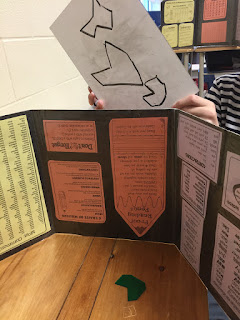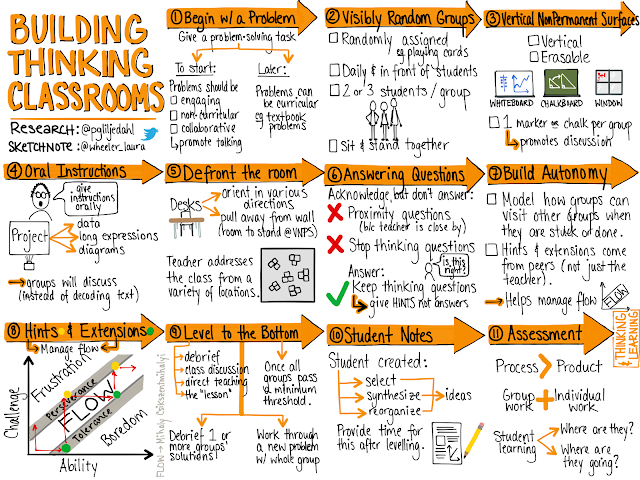Geometry and 3D Printing
The topic of geometric properties has become the focus of our latest mathematics spiral. The possible connections with spatial reasoning and 3D printing have become quite obvious as we have worked our way through various explorations.
Specific Curriculum Expectations:
- Sort and classify triangles and quadrilaterals by geometric properties related to symmetry, angles, and sides, through investigation using a variety of tools and strategies
- Identify, through investigation, the minimum side and angle information needed to describe a unique triangle
- Determine, through investigation using a variety of tools relationships among area, perimeter, corresponding side lengths, and corresponding angles of congruent shapes
- Demonstrate an understanding that enlarging or reducing two-dimensional shapes creates similar shapes
Exploration 1: Student Guessing Game
Students worked with a partner to classify polygons according to geometric properties. One partner selected a plastic polygon and held it behind a barrier. This partner provided clues to help the other student draw the correct shape. This activity also involved significant spatial reasoning as the task involved creating mental images corresponding to the given clues in order to draw the correct polygon. I noticed students using hand gestures to ask questions (eg. folding hands to show symmetry, hands extended to show parallel sides, holding hands into position of angles). Although these students were not following the rules of the game, it did provide a glimpse into their thinking.
Examples of student clues:
"The shape is a polygon. It has 8 vertices. It is concave/irregular. It has an interior reflex angle. It has no lines of symmetry. It has one pair of parallel sides."
"It has 4 acute angles and 4 reflex angles. It has 4 lines of symmetry. It is a concave and irregular polygon. It has 8 vertices's and 8 sides. All sides are equal. It has no parallel sides. It has rotational symmetry."
Exploration 2: Designing Shapes for Primary Students

On quite a few occasions, primary teachers at our school have knocked on our classroom door looking for attribute blocks. I am lucky to have my own set (fortunate hand-me-down from my retired teacher mom) and am happy to lend it out as we have a shortage in our school inventory.
Over the years a few pieces have become missing and I requested that the Grade 7s help me print some new ones using our 3D printer - an opportunity to further develop our skills with designing and creating using our 3D printer while also filling a need for our school community.
Students thought it might also be helpful to create additional shapes for student use including a wider variety of regular and irregular polygons.
Examples of student thinking during design process:
 "For the regular octagon we got a box and made it 10mm high and 20mm by 20mm wide. Then we got another box and put a hole threw it so then it could become a triangle we did that 4 times. After that we put all the blocks together and then grouped it and got our shape of a regular octagon."
"For the regular octagon we got a box and made it 10mm high and 20mm by 20mm wide. Then we got another box and put a hole threw it so then it could become a triangle we did that 4 times. After that we put all the blocks together and then grouped it and got our shape of a regular octagon."
"For the irregular octagon we started with a square, then we had to make 2 triangles to go on the side of it, Next we got a square and put it underneath and duplicated one of the triangles from before and then had two more triangles to put on the side of it. And finally we grouped together."
Specific Curriculum Expectations:
- Sort and classify triangles and quadrilaterals by geometric properties related to symmetry, angles, and sides, through investigation using a variety of tools and strategies
- Identify, through investigation, the minimum side and angle information needed to describe a unique triangle
- Determine, through investigation using a variety of tools relationships among area, perimeter, corresponding side lengths, and corresponding angles of congruent shapes
- Demonstrate an understanding that enlarging or reducing two-dimensional shapes creates similar shapes
Exploration 1: Student Guessing Game
Students worked with a partner to classify polygons according to geometric properties. One partner selected a plastic polygon and held it behind a barrier. This partner provided clues to help the other student draw the correct shape. This activity also involved significant spatial reasoning as the task involved creating mental images corresponding to the given clues in order to draw the correct polygon. I noticed students using hand gestures to ask questions (eg. folding hands to show symmetry, hands extended to show parallel sides, holding hands into position of angles). Although these students were not following the rules of the game, it did provide a glimpse into their thinking.
Examples of student clues:
"The shape is a polygon. It has 8 vertices. It is concave/irregular. It has an interior reflex angle. It has no lines of symmetry. It has one pair of parallel sides."
"It has 4 acute angles and 4 reflex angles. It has 4 lines of symmetry. It is a concave and irregular polygon. It has 8 vertices's and 8 sides. All sides are equal. It has no parallel sides. It has rotational symmetry."
Exploration 2: Designing Shapes for Primary Students

On quite a few occasions, primary teachers at our school have knocked on our classroom door looking for attribute blocks. I am lucky to have my own set (fortunate hand-me-down from my retired teacher mom) and am happy to lend it out as we have a shortage in our school inventory.
Over the years a few pieces have become missing and I requested that the Grade 7s help me print some new ones using our 3D printer - an opportunity to further develop our skills with designing and creating using our 3D printer while also filling a need for our school community.
Students thought it might also be helpful to create additional shapes for student use including a wider variety of regular and irregular polygons.
Examples of student thinking during design process:
 "For the regular octagon we got a box and made it 10mm high and 20mm by 20mm wide. Then we got another box and put a hole threw it so then it could become a triangle we did that 4 times. After that we put all the blocks together and then grouped it and got our shape of a regular octagon."
"For the regular octagon we got a box and made it 10mm high and 20mm by 20mm wide. Then we got another box and put a hole threw it so then it could become a triangle we did that 4 times. After that we put all the blocks together and then grouped it and got our shape of a regular octagon.""For the irregular octagon we started with a square, then we had to make 2 triangles to go on the side of it, Next we got a square and put it underneath and duplicated one of the triangles from before and then had two more triangles to put on the side of it. And finally we grouped together."
We have just begun printing these shapes ... stay tuned for project progress!



This comment has been removed by a blog administrator.
ReplyDeleteThis comment has been removed by a blog administrator.
ReplyDeleteThis comment has been removed by a blog administrator.
ReplyDeleteYour blog is very meaningful and helpful for me. Thanks a lot to share this kind of material.
ReplyDeletehttps://blog.mindvalley.com/spatial-reasoning/
Thanks for your valuable information on 3D printing.
ReplyDeleteHere is the Trends of 3D Printing Production of 2019